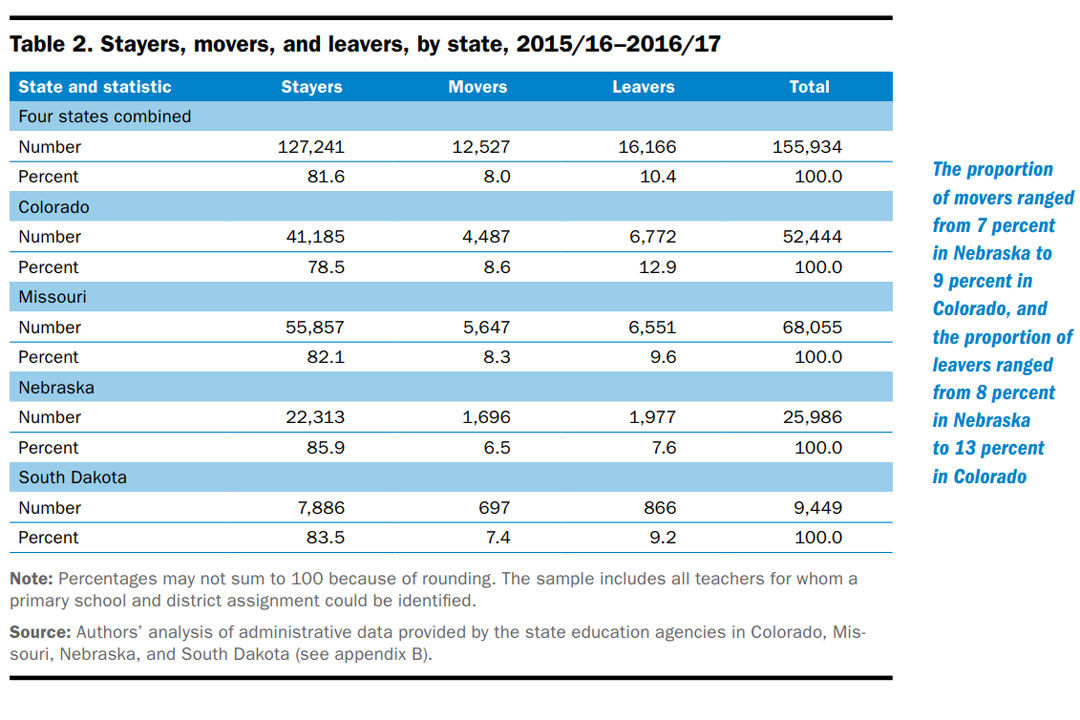A recent study by REL Central and four central region state education departments found that, on average, 10.4 percent of teachers in Colorado, Missouri, Nebraska, and South Dakota left the teaching profession during the 2015/16 and 2016/17 school years. The percentage did not come as a shock to education department leaders who saw the results as a call for further efforts to improve retention rates and acquisition strategies.
The Colorado Department of Education (CDE), Missouri Department of Elementary and Secondary Education (MO DESE), Nebraska Department of Education (NDE), and South Dakota Department of Education (SD DOE) have each developed and begun implementation of programs and strategies to address the effects associated with teacher movement in their states. Those effects range from issues of teacher quality to increased training costs incurred by schools and education systems. Still, to ensure an accurate strategic focus and to improve their retention and acquisition programs, these state education departments collaborated with REL Central to get a closer look at the proportions of teachers who stay in the same schools, move to different schools, or leave the state public school system. The result of that collaboration was a REL Central report released earlier this month, Teacher Retention, Mobility, and Attrition in Colorado, Missouri, Nebraska, and South Dakota.
“This report verifies what we have already been observing,” said Paul Katnik, assistant commissioner for MO DESE. “We need to beef up our educator pipeline, especially our Grow Your Own programs [which aim to recruit teacher candidates for local teaching career opportunities]. In addition, we know that many teachers are leaving the profession because they don’t feel supported. Our districts need to create teacher supports so that we can reduce costs and improve education equity for our schools.”

Using 2015/16 and 2016/17 data from the states’ administrative data systems, researchers working on the report found that for the four states 81.6 percent of teachers stayed in the same schools, 8 percent moved to different schools, and 10.4 percent took nonteaching positions or left the public school system. That data is in comparison to 2012/2013 national data that suggest that 84 percent of teachers stay in the same schools, 8 percent move to different schools, and 8 percent leave the profession from year to year (Goldring, Taie, & Riddles, 2014).
While the combined data for the four states described teachers leaving the school systems at a somewhat higher rate than the 2012/2013 national numbers, proportions of teachers who stayed, moved, and left varied between the four states. For example, the percentage of teachers who moved to different schools was highest in Colorado, at 8.6 percent, and lowest in Nebraska, at 6.5 percent. Furthermore, 12.9 percent of Colorado teachers exited the school system or teaching profession in comparison to 7.7 percent of teachers who did so in Nebraska.
Reviewing the data, Carolyn Haug, director of research and impact for CDE, pointed to the nearly 13 percent of teachers exiting the Colorado school system as a critical issue. She expressed that her greatest concern was for reducing the numbers of teachers leaving the school system – especially for schools in rural or disadvantaged communities where resources for salaries, training, and other opportunities may be limited.
“When experienced teachers move from one district to another, they would go through an induction, but it would be those who are leaving the profession that are much more costly,” said Haug. “Those costs are huge, not only for the person who invested so much in becoming a teacher, but also for the district and the school who no longer has that trained personnel to draw on. That is just a resource that is lost from the entire system.”
Haug noted that the study’s data would be used to increase buy-in for the state’s teacher-shortage strategic action plan, which addresses many of her concerns. The plan includes consideration of salary equalization aid, student loan forgiveness, supplemental compensation for hard-to-staff schools, particularly in rural areas, and many other strategies. In addition, Haug sees CDE and Colorado districts using the study to improve messaging to attract new teachers.
Katnik agreed with Haug that the report would be helpful in encouraging buy-in for state initiatives designed to address teacher retention and recruitment. He explained that the report’s district-specific information will help MO DESE better determine teacher movement between districts, and it will help motivate district leaders to implement MO DESE recommended teacher support programs.
With the report now out, Haug and Katnik, as well as the departments they serve, see it as another tool to help them address not just the teacher retention, attrition and mobility that it describes, but to help them fill their classrooms with excellent teachers to ensure an equitable education for all children.
Read the report and discover more about teacher movement in the central region.
Resource:
Goldring, R., Taie, S., & Riddles, M. (2014). Teacher attrition and mobility: Results from the 2012–13 Teacher Follow-up Survey (NCES 2014-077). Washington, DC: U.S. Department of Education, Institute of Education Sciences, National Center for Education Statistics. Retrieved from https://nces.ed.gov/pubsearch/pubsinfo.asp?pubid=2014077





